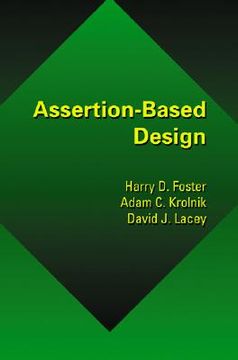Share
Assertion-Based Design (in English)
Harry Foster
(Author)
·
Adam Krolnik
(Author)
·
David Lacey
(Author)
·
Springer
· Hardcover
Assertion-Based Design (in English) - Foster, Harry ; Krolnik, Adam ; Lacey, David
$ 93.79
$ 99.00
You save: $ 5.21
Choose the list to add your product or create one New List
✓ Product added successfully to the Wishlist.
Go to My WishlistsIt will be shipped from our warehouse between
Friday, July 05 and
Monday, July 08.
You will receive it anywhere in United States between 1 and 3 business days after shipment.
Synopsis "Assertion-Based Design (in English)"
1 Introduction.- 1.1 Property checking.- 1.2 Verification techniques.- 1.3 What is an assertion?.- 1.3.1 A historical perspective.- 1.3.2 Do assertions really work?.- 1.3.3 What are the benefits of assertions?.- 1.3.4 Why are assertions not used?.- 1.4 Phases of the design process.- 1.4.1 Ensuring requirements are satisfied.- 1.4.2 Techniques for ensuring consistency.- 1.4.3 Roles and ownership.- 1.5 Summary.- 2 Assertion Methodology.- 2.1 Design methodology.- 2.1.1 Project planning.- Project documents.- EDA and internal tools.- RTL styles and conventions.- Support infrastructure.- Partner coordination.- 2.1.2 Design requirements.- 2.1.3 Design documents.- 2.1.4 Design reviews.- 2.1.5 Design validation.- 2.2 Assertion methodology for new designs.- 2.2.1 Key learnings.- 2.2.2 Best practices.- 2.2.3 Assertion density.- 2.2.4 Process for adding assertions.- 2.2.5 When not to add assertions.- 2.3 Assertion methodology for existing designs.- 2.4 Assertions and simulation.- 2.5 Assertions and formal verification.- 2.5.1 Formal verification framework.- 2.5.2 Formal methodology.- 2.5.3 ECC example.- 2.6 Summary.- 3 Specifying RTL Properties.- 3.1 Definitions and concepts.- 3.1.1 Property.- 3.1.2 Events.- 3.2 Property classification.- 3.2.1 Safety versus liveness.- 3.2.2 Constraint versus assertion.- 3.2.3 Declarative versus procedural.- 3.3 RTL assertion specification techniques.- 3.3.1 RTL invariant assertions.- OVL invariant 6.- PSL invariant 7.- 3.3.2 Declaring properties with PSL.- 3.3.3 RTL cycle related assertions.- 3.3.4 PSL and default clock declaration.- 3.3.5 Specifying sequences.- Declaring sequences within PSL 8.- Sequence operators within PSL 8.- Checking sequences with the OVL 8.- 3.3.6 Specifying eventualities.- OVL event bounded window checkers 8.- 3.3.7 PSL built-in functions.- 3.4 Pragma-based assertions.- 3.5 SystemVerilog assertions.- 3 5 1 Immediate assertions.- 3.5.2 Concurrent assertions.- Sequence declaration 9.- Sequence operations 9.- Repetition operators 9.- First match operator 9.- Throughout operators 9.- Dynamic variables within sequences 9.- 3.5.3 System functions.- 3.6 PCI property specification example.- 3.6.1 PCI overview.- 3.7 Summary.- 4 PLI-Based Assertions.- 4.1 Procedural assertions.- 4.1.1 A simple PLI assertion.- Checktf routine 11.- Calltf routine 11.- 4.1.2 Assertions within a simulation time slot.- Nested PLI assertion problem 11.- 4.1.3 Assertions across simulation time slots.- Controlling assertion evaluations by a clock 11.- 4.1.4 False firing across multiple time slots.- 4.2 PLI-based assertion library.- 4.2.1 Assert quiescent state.- 4.3 Summary.- 5 Functional Coverage.- 5.1 Verification approaches.- 5.2 Understanding coverage.- 5.2.1 Controllability versus observability.- 5.2.2 Types of traditional coverage metrics.- 5.2.3 What is functional coverage?.- 5.2.4 Building functional coverage models.- 5.2.5 Sources of functional coverage.- 5.3 Does functional coverage really work?.- 5.3.1 Benefits of functional coverage.- 5.3.2 Success stories.- 5.3.3 Why is functional coverage not used.- 5.4 Functional coverage methodology.- 5.4.1 Steps to functional coverage.- 5.4.2 Correct coverage density.- 5.4.3 Incorrect coverage density.- 5.4.4 Coverage analysis.- Coverage data organization 15.- Tracking functional coverage 15.- Actions to take 15.- 5.4.5 Coverage best practices.- 5.4.6 Coverage-driven test generation.- 5.5 Specifying functional coverage.- 5.5.1 Embedded in the RTL.- 5.5.2 Functional coverage libraries.- 5.5.3 Assertion-based methods.- 5.5.4 Post processing.- 5.5.5 PLI logging and reporting.- 5.5.6 Simulation control.- 5.6 Functional coverage examples.- 5.7 AHB example.- 5.8 Summary.- 6 Assertion Patterns.- 6.1 Introduction to patterns.- 6.1.1 What are assertion patterns?.- 6.1.2 Elements of an assertion pattern.- 6.2 Signal patterns.- 6.2.1 X detection pattern.- 6.2.2 Valid range pattern.- 6.2.3 One-hot pattern.- 6.2.4 Gray-code pattern.- 6.3 Set patterns.- 6.3.1 Valid opcode pat...
- 0% (0)
- 0% (0)
- 0% (0)
- 0% (0)
- 0% (0)
All books in our catalog are Original.
The book is written in English.
The binding of this edition is Hardcover.
✓ Producto agregado correctamente al carro, Ir a Pagar.

